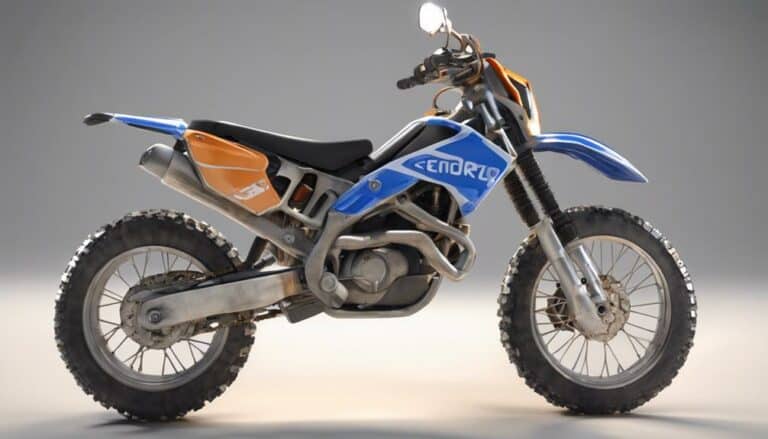When it comes to maintaining enduro dirt bikes for extreme terrain riding, proper washing and cleaning techniques can greatly impact your bike's performance and longevity.
Discover practical tips on how to keep your bike in top shape for those demanding rides. From air filter maintenance to chain and sprocket care.
Stay tuned to uncover the essential practices that will help you conquer the toughest terrains with confidence and reliability.
Key Takeaways
- Thoroughly clean with water and brushes, avoiding high-pressure washers.
- Maintain air filter regularly for optimal engine performance.
- Check brake system, fluid levels, and lines for safety.
- Follow manufacturer's guidelines for oil changes and chain maintenance.
Washing and Cleaning Techniques
To guarantee the longevity and peak performance of your enduro dirt bike, thorough washing and cleaning are essential steps after each ride. Neglecting this important maintenance can lead to premature wear and tear on critical components like air filters, fork seals, and even impact tire pressure.
Start by using water and brushes to remove mud, dirt, and debris that can cause damage. Avoid high-pressure washers that may harm the bike's delicate parts. After cleaning, make sure the bike is dried thoroughly to prevent rust and corrosion. Speed up the drying process by using a dryer or leaf blower. Remember to use an airbox cover to shield the carburetor from water during washing.
Air Filter Maintenance and Care
Regular maintenance of the air filter is important for optimal engine performance and longevity in your enduro dirt bike. Neglecting the air filter can allow dirt and debris to enter the engine, leading to decreased performance and potential damage. To guarantee your engine runs smoothly, follow these steps for air filter maintenance and care:
| Task | Description |
|---|---|
| Check air filter regularly | Inspect for dirt and debris buildup. |
| Clean air filter | Use high-quality air filter cleaner. |
| Apply air filter oil after cleaning | Maintain the best engine protection. |
Brake System Inspection and Maintenance
Inspecting your dirt bike's brake system regularly is important for maintaining peak performance and safety on challenging terrains. Here are some key steps to make sure your brake system is in top condition:
- Check Brake Pads: Regularly inspect your brake pads for wear and tear. Replace them if they're worn beyond the manufacturer's recommendations to maintain effective braking power.
- Monitor Brake Fluid: Keep an eye on the brake fluid levels and quality. Make sure the fluid is clean and at the correct level to guarantee best braking performance, especially in extreme terrain conditions.
- Bleed the Brake System: Periodically bleed the brake system to remove any air bubbles that may have entered the system. This process helps maintain consistent brake feel and responsiveness.
- Inspect Brake Lines: Check the brake lines for any signs of leaks, cracks, or damage. Damaged brake lines can compromise braking efficiency and should be addressed promptly to ensure safety during your enduro rides.
Engine and Fork Oil Change Procedures
Ensuring peak performance of your dirt bike's engine and fork suspension demands regular oil changes at specified intervals. For the engine oil change, it is important to follow the manufacturer's recommendations, typically every 15-20 hours of riding. Using a high-quality oil that meets the specific requirements of your dirt bike engine is essential to maintain its longevity and performance. Always refer to the owner's manual for the recommended oil change intervals and the correct oil viscosity to use.
When it comes to the fork oil change, it is advised to replace the fork oil every 30-40 hours of riding. This helps to maintain the smooth operation of your suspension system, allowing for better handling and control on extreme terrains. Properly disposing of the used oil is also important, following environmental regulations and guidelines to protect the environment.
| Engine Oil Change | Fork Oil Change |
|---|---|
| Every 15-20 hours | Every 30-40 hours |
| High-quality oil | Ensure smooth suspension |
| Follow manual | Better handling |
Chain and Sprocket Care and Maintenance
To maintain peak performance and longevity of your dirt bike, it's imperative to prioritize the care and maintenance of the chain and sprockets. Neglecting these critical components can lead to premature wear and decreased efficiency on the trail.
Here are four essential steps to make sure your chain and sprockets are in top condition:
- Regular Inspection: Check the chain for wear, tightness, and alignment after each ride to prevent damage and guarantee proper functioning.
- Cleaning Routine: Use a quality chain cleaner to rid the chain of dirt and debris that can cause abrasion and reduce lifespan.
- Lubrication: Apply a suitable chain lube regularly to maintain smooth operation and reduce friction between moving parts.
- Proper Tension: Adjust the chain tension as needed to prevent damage to the drivetrain components and ensure top performance on challenging terrains.
Conclusion
To sum up, remember that proper maintenance is key to ensuring your enduro dirt bike performs at its best in extreme terrain.
Did you know that regular air filter cleaning can increase engine performance by up to 5%?
By following the best practices outlined in this article, you can enjoy smoother rides and better durability for your bike.
Stay proactive in your maintenance routine to maximize your off-road adventures.

